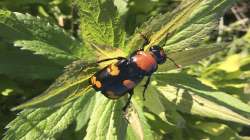Beetle trapped in amber provides earliest evidence of insect pollination
The first known instance of an insect pollinating a flower happened 99 million years ago, according to a study which pushes the earliest documented instance of the process back by at least 50 million years than previously thought

The first known instance of an insect pollinating a flower happened 99 million years ago, according to a study which pushes the earliest documented instance of the process back by at least 50 million years than previously thought.
The study, published in the journal PNAS, is based on the discovery of fossilised remains of a tumbling flower beetle with pollen on its legs preserved in amber deep inside a mine in northern Myanmar.
The researchers, including David Dilcher from Indiana University in the US, said the 62 pollen samples discovered in the amber showed features indicating they had evolved to spread through contact with insects.
These features, they said, included the pollen's size, "ornamentation" and clumping ability.
The study noted that the grains may have also originated from a flower species in the group eudicots -- one of the most common types of flowering plant species.
The researchers said the powdery pollen matter was not easy to find as it was hidden in the insect's body hair, and could be discovered only under a probing technique called confocal laser microscopy.
They said the analysis could be made as pollen grains glow under fluorescence light -- contrasting strongly with the darkness of the insect's shell.
The insect in the amber, the study noted, is a newly discovered species of beetle, which the authors named Angimordella burmitina.
According to the researchers, the insect had several specialized physical structures such as body shape and pollen-feeding mouthparts, suggesting that it played a role as a pollinator.
The physical features of the insect were revealed through an imaging technique called X-ray microcomputed tomography, or micro-CT, the study noted.
"It's exceedingly rare to find a specimen where both the insect and the pollen are preserved in a single fossil," said Dilcher.
"Aside from the significance as earliest known direct evidence of insect pollination of flowering plants, this specimen perfectly illustrates the cooperative evolution of plants and animals during this time period, during which a true exposition of flowering plants occurred," he added.
ALSO READ | Tips and Tricks to keep your floral arrangements fresh for long hours
ALSO READ | Want to know when flowers originated? Scientists solve the mystery